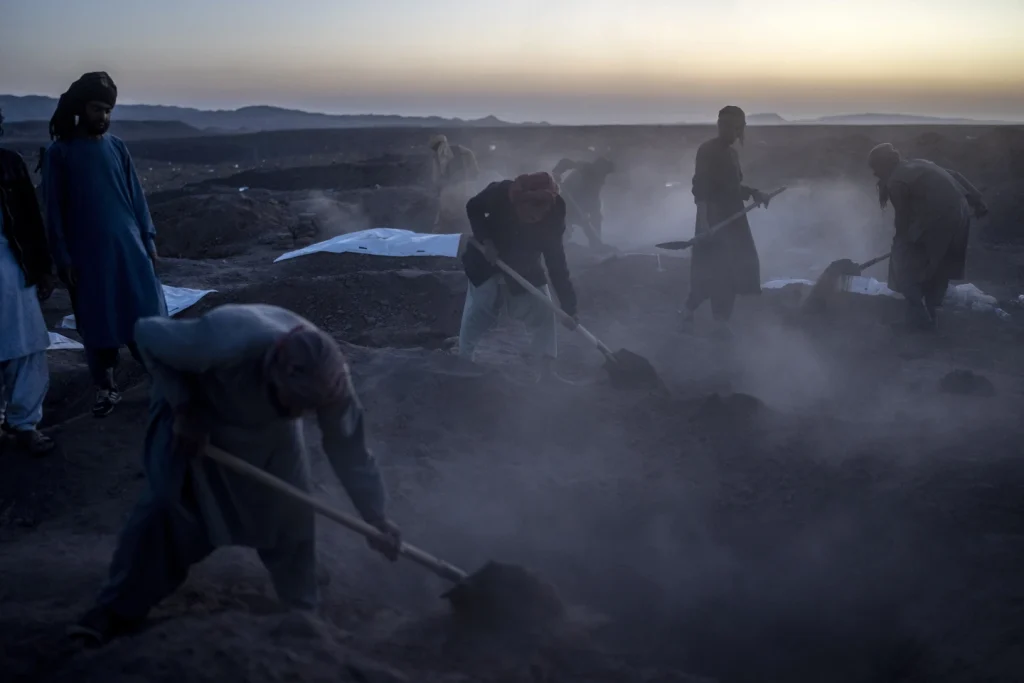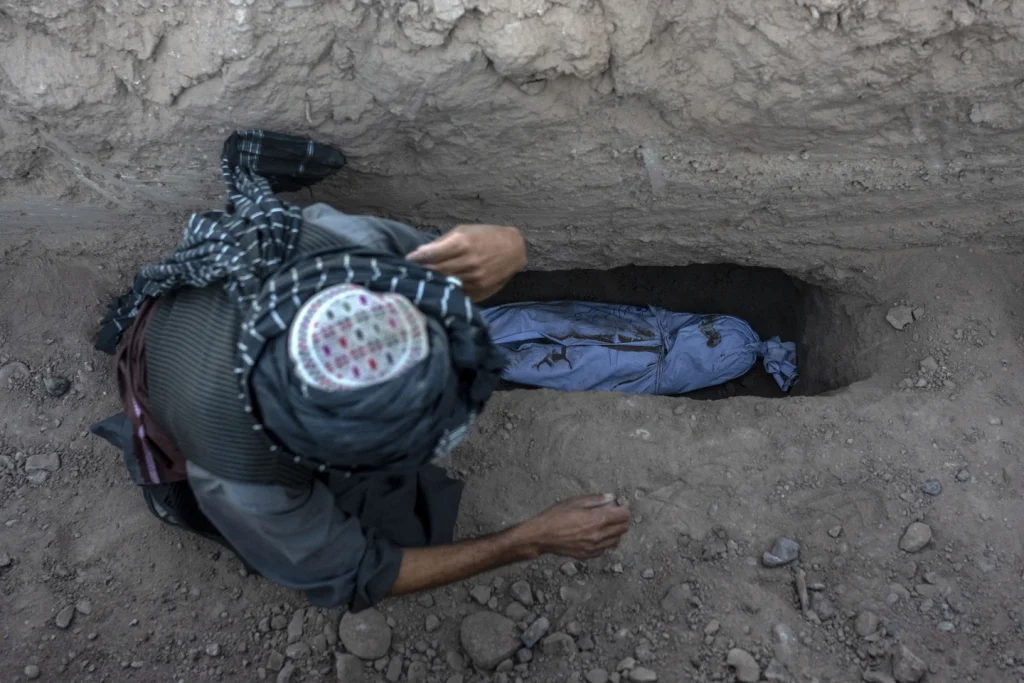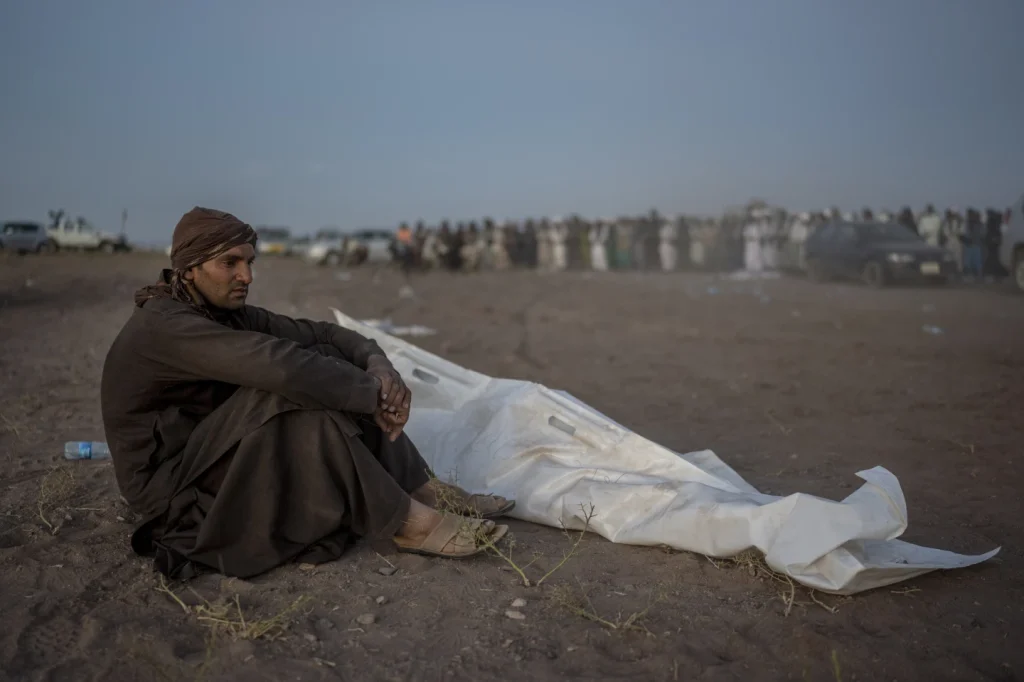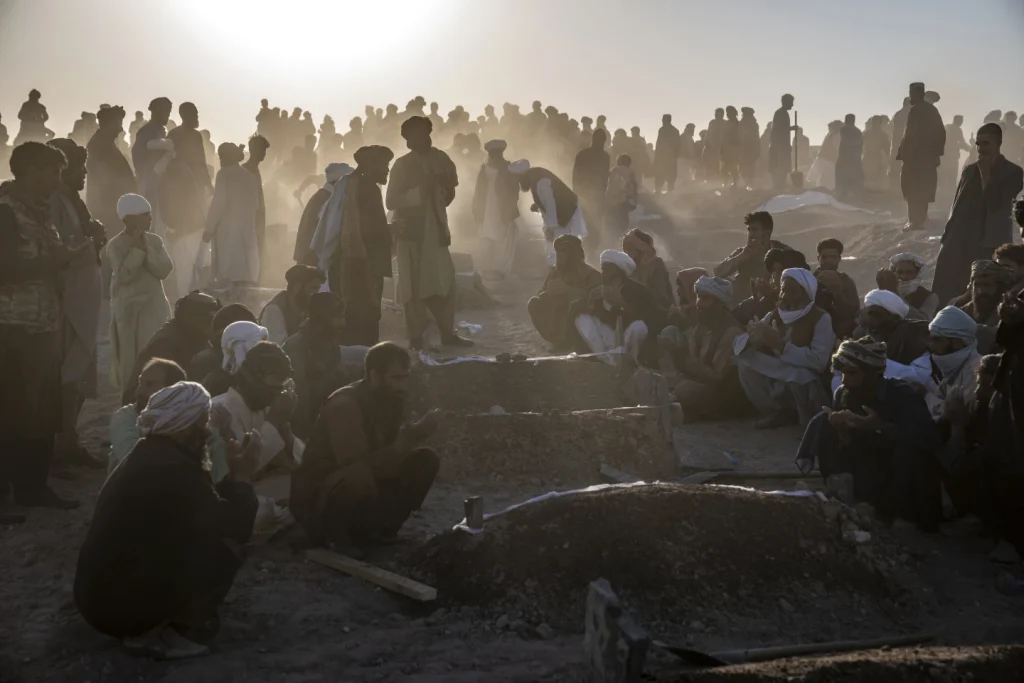In the aftermath of one of the deadliest earthquakes in the region, the small village of Zinda Jan in western Herat province of Afghanistan remains gripped by a desperate search for survivors.
Despite the passing of three days since the catastrophic event, the resilient Afghan rescuers and villagers continue to tirelessly dig through the rubble, clinging to hope that they may still find someone alive.
The devastating 6.3 magnitude quake, which struck on Saturday, has already claimed the lives of over 2,000 people, leaving behind a trail of grief and destruction.
As the residents of Herat mourn their loved ones, who tragically lost their lives in the disaster, the solemn task of digging graves has begun. In the district of Zinda Jan, a barren field has been transformed into a somber resting place, as a bulldozer clears the earth to make way for a long row of graves.
The process is heart-wrenching, as families must grapple with the reality of losing a family member, only to bury them moments later in a nearby grave, once again beneath the ground.
Mir Agha, a compassionate volunteer from the city of Herat, shares his firsthand experience of the challenges faced by the community in Zinda Jan, as he joins hundreds of others in their efforts to support and assist the locals during this trying time.

Stretching across vast distances of arid, undulating terrain, the remnants of once-thriving villages lay in ruins, their humble structures reduced to mere rubble.
The desolate scenes that unfolded before one’s eyes were hauntingly silent, punctuated only by the somber processions of mourning that marked the passing of lives lost.
The devastation that had befallen these communities was as heart-wrenching as it was profound, leaving behind a landscape scarred by the ravages of conflict and the unforgiving passage of time.
The very essence of these villages had been extinguished, leaving behind a poignant reminder of the fragility of human existence and the enduring consequences of violence and upheaval.
In the village of Naib Rafi, which had a population of approximately 2,500 residents, reports indicate that the majority of the victims were men who were working outside when the earthquake struck.
The devastation was so severe that survivors had to work tirelessly throughout the day, utilizing excavators to dig extensive trenches for mass burials.
Janan Sayiq, a spokesperson for the Afghan Taliban government’s national disaster authority, acknowledged that the earthquake resulted in the deaths and injuries of thousands, although an exact breakdown of the casualties was not provided.
Prior to this, Taliban officials had already reported that over 2,000 individuals had lost their lives in the province of Herat.
According to the U.S. Geological Survey, the epicenter of the earthquake was located approximately 40 kilometers (25 miles) northwest of Herat, the provincial capital.
The region has also experienced numerous aftershocks, some of which have been quite strong. In fact, on Monday, another powerful aftershock occurred, causing residents of the city to once again evacuate their homes in a state of panic and seek safety elsewhere.
The continuous occurrence of such aftershocks only adds to the fear and uncertainty that the affected communities are currently facing.
According to the United Nations, the Zinda Jan district has been identified as the worst-affected area, with a staggering number of 1,294 reported deaths and 1,688 injuries.
Additionally, the district is currently grappling with the distressing reality that 485 individuals, comprising 191 men and 294 women, remain missing.
The devastating impact of the earthquake is further exacerbated by the destruction of six schools within the district, as reported by the U.N.

Furthermore, the Taliban has disclosed that nearly 2,000 houses in 20 villages have been reduced to ruins, intensifying the magnitude of the calamity.
It is disheartening to note that the district, already grappling with the aftermath of this catastrophic event, is further burdened by the scarcity of medical resources, with only one government-run hospital serving the entire affected area.
The extent of the devastation is truly overwhelming, and immediate assistance and support are crucial in order to alleviate the suffering of those affected and to facilitate the process of recovery and rebuilding.
As winter draws near, aid organizations have cautioned that the new disaster will further complicate the ability of people to access essential necessities like housing, food, and medicine.
The extent of foreign assistance received by Herat since Saturday remains uncertain. The international response to the earthquake has been sluggish, as many countries are hesitant to engage directly with the Taliban-led government.

Additionally, global attention has been diverted to the deadly conflict between Israel and the Palestinians following the surprise attack by Gaza militants on Saturday.
Pakistan has made a commitment to send blankets, tents, and medicines, while China has reportedly offered financial assistance and other emergency humanitarian aid.
Other foreign governments have stated their intention to collaborate with local aid organizations in order to assist with rescue and recovery efforts. Additionally, Afghan citizens have initiated fundraising campaigns to contribute to the relief efforts.
The Afghanistan authorities in Kabul have not provided any information regarding the amount of aid received from overseas.
The Taliban’s justice ministry has called upon national and international charitable foundations, businesspeople, and Afghan citizens to gather aid for the province.
In a statement, the ministry expressed the urgent need for humanitarian assistance in Herat province due to the extensive damage and casualties caused by the earthquake.
On Monday, Abdul Ghani Baradar, the Taliban-appointed deputy prime minister for economic affairs, along with his team, visited the region affected by the earthquake.
Their objective was to provide immediate relief assistance and ensure the fair and proper distribution of aid, according to authorities.
The supreme leader of the Taliban has not publicly addressed the earthquake thus far.
Senior United Nations officials in Afghanistan also traveled to Zinda Jan to evaluate the extent of the damage.

In neighboring Pakistan, the government held a special session to review aid for Afghanistan, which includes relief teams, food, medicine, tents, and blankets.
The International Rescue Committee reported that crucial infrastructure, such as bridges, has been destroyed, and emergency response teams have been dispatched to offer humanitarian aid.
According to Sayiq, a representative from the disaster authority, over 35 teams from both the military and nonprofit organizations are currently engaged in rescue operations.
Afghanistan has been grappling with several recent disasters, adding to the challenges faced by its population. In March, a powerful magnitude 6.5 earthquake struck western Pakistan and eastern Afghanistan, causing significant damage.
Additionally, in June 2022, another earthquake hit eastern Afghanistan, resulting in the destruction of stone and mud-brick homes and claiming the lives of at least 1,000 individuals. These disasters have further compounded the difficulties experienced by Afghan communities.
